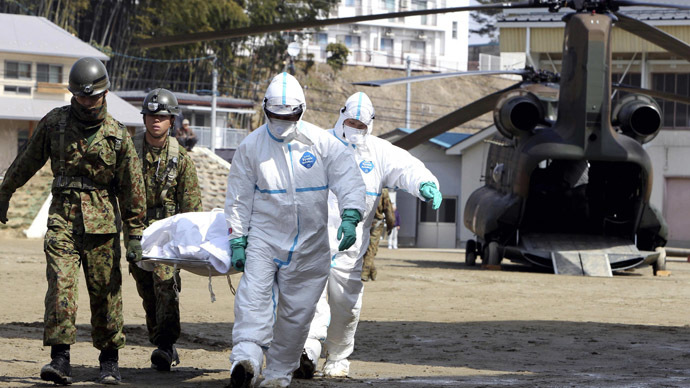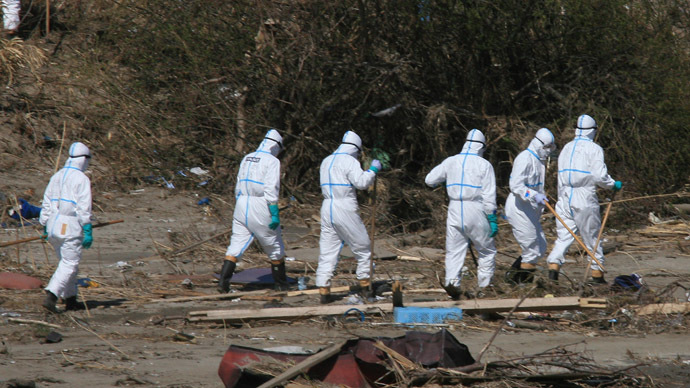Around 90 percent of workers at Fukushima nuclear power plant fled the crippled facility at the height of the 2011 meltdown, according to a previously undisclosed report that challenges the timeline of events surrounding the disaster.
EDITOR’S NOTE: In September 2014, Japanese newspaper Asahi Shimbun issued an apology over a false report after it admitted that its story was based on false leaks from a Japanese government inquiry into Fukushima.
A copy of the document, consisting of more than 400 pages obtained by the Japanese Asahi Shimbun newspaper said that four days after the plant was hit by a tsunami, employees abandoned their posts at the plant, fearing that the core of No. 2 reactor could go into meltdown, contaminating the area.
Based on a number of government conducted interviews into the matter, the report cites Masao Yoshida, Fukushima plant manager at the time, who testified that 650 workers and midlevel managers fled to another nuclear facility 10km away, despite his orders to be on stand-by. Only he and 69 other employees remained on site to try to regain control of the plant’s failing reactors, he testified. All in all Ashida, who died last year of esophageal cancer, was questioned by the investigative committee on 13 separate occasions for a total of 29 hours and 16 minutes.
Yoshida's questioning revealed that he – while stationed at the emergency command center – received two reports around 6:15am on March 15, 2011, both pointing out to signs that the No. 2 reactor containment vessel was damaged.
However radiation levels were not increasing in the emergency command center, prompting Yoshida judgment call that the containment vessel was not damaged. But as a precautionary measure, at 6:42am Yoshida ordered temporarily evacuation of workers to comparatively lower radiation locations within the plant’s territory. In that case when needed they would be able to return to their posts, if no abnormalities at the nuclear plant were reported.
Most of the workers, however, by 7am had made it to Fukushima No. 2 nuclear power plant – as far as 10km south of Plant No. 1. Yoshida told the government panel that workers told drivers of the buses waiting outside the command center to take them to Fukushima No. 2 plant. According to the document, Yoshida said that he “never told the workers to go [to the No. 2 plant].”
“I thought I gave an order to temporarily evacuate to a location where radiation levels were low near the Fukushima No. 1 plant and await further instructions. After the workers arrived at the No. 2 plant, I contacted them and asked that the group managers be the first to return,” he told interviewers.
At their time of the absence of 90 percent of the workforce, it is believed that a fire occurred at the No. 4 reactor while radiation levels skyrocketed near the main gate of the No. 1 plant. White steam was also seen spewing out of the No. 2 reactor. Overall, four reactors were severely damaged in the aftermath of a disaster that struck in March 2011.

If Yoshida's testimony stands, it would challenge Tokyo Electric Power Company’s (TEPCO) account of the events that claimed that almost everyone except a small team of workers were evacuated.
TEPCO, the operator of the No. 1 plant, has never disclosed any information about orders issued by Yoshida for workers to remain at the plant rather than go to No. 2 facility. The operator now claims that plant manager’s orders were flexible.
“Evacuating temporarily to the No. 2 plant was not a violation of regulations because Yoshida’s order left open the possibility of leaving for the No. 2 plant if there were no locations at the No. 1 plant, where radiation levels were low,” a TEPCO official explained.
Meanwhile on Wednesday, TEPCO released a statement saying that it has begun releasing underground water at No. 1 reactor into the Pacific Ocean, ITAR-TASS reports. The company says that the water radiation level will not affect the environment. Earlier TEPCO said that only water with 1,500 becquerels of radiation or fewer per liter would be released.

